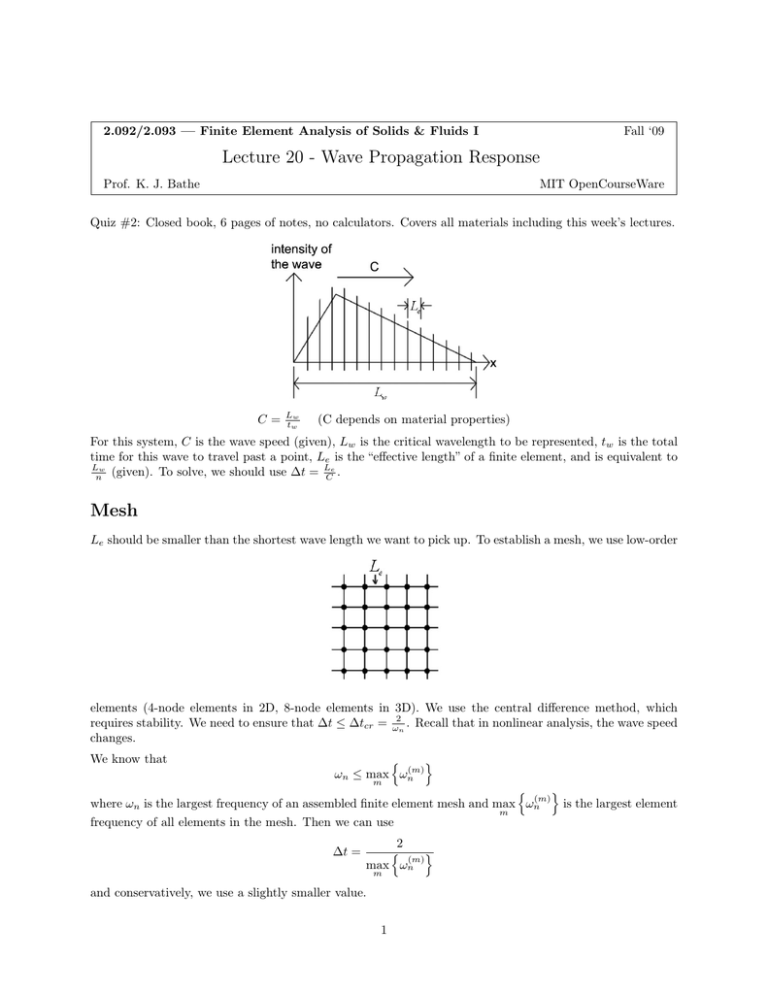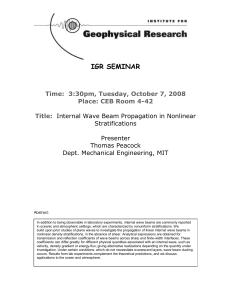Lecture 20 - Wave Propagation Response
advertisement

2.092/2.093 — Finite Element Analysis of Solids & Fluids I Fall ‘09 Lecture 20 - Wave Propagation Response Prof. K. J. Bathe MIT OpenCourseWare Quiz #2: Closed book, 6 pages of notes, no calculators. Covers all materials including this week’s lectures. C= Lw tw (C depends on material properties) For this system, C is the wave speed (given), Lw is the critical wavelength to be represented, tw is the total time for this wave to travel past a point, Le is the “effective length” of a finite element, and is equivalent to Lw Le n (given). To solve, we should use Δt = C . Mesh Le should be smaller than the shortest wave length we want to pick up. To establish a mesh, we use low-order elements (4-node elements in 2D, 8-node elements in 3D). We use the central difference method, which requires stability. We need to ensure that Δt ≤ Δtcr = ω2n . Recall that in nonlinear analysis, the wave speed changes. We know that � � ωn ≤ max ωn(m) m � � (m) where ωn is the largest frequency of an assembled finite element mesh and max ωn is the largest element m frequency of all elements in the mesh. Then we can use Δt = 2 � � (m) max ωn m and conservatively, we use a slightly smaller value. 1 Lecture 20 Wave Propagation Response 2.092/2.093, Fall ‘09 (m) How to Find ωn (m) For lower-order elements, we have bounds for ωn . (See Sections 9.3/9.4 and Table 9.5 that gives formulae (m) for ωn .) Proof: We know � � φTn ΣK (m) φn � �m (a) ωn2 = T φn ΣM (m) φn m ωn2 ΣU (m) = m (b) ΣJ (m) m U (m) = φnT K (m) φn J (m) = φTn M (m) φn Note that K (m) is of the same size as K. Also, for an element (m), since φn is not an eigenvector for K (m) : � �2 φTn K (m) φn (m) ≤ ω n φnT M (m) φn � �2 U (m) ≤ J (m) ωn(m) (c) Plug (c) into (b) and we have ωn2 ≤ � �2 (m) ΣJ (m) ωn m ≤ max ΣJ (m) �� m ωn(m) �2 � m In practice, wave propagation problems are very difficult to solve, due to reflections, absorptions, and the many different wave types (shear waves, etc.). As mentioned, the central difference method is almost always used for wave propagation solutions, because wave propagation modeling needs fine meshes. In beams, rotational DOFs result in high frequencies, so rotational mass is frequently set to zero. If we have zero masses in the model, we need to use static condensation. � � �� � � �� Kaa Kab φa Ma 0 φa 2 =ω Kba Kbb φb 0 0 φb No mass on b-DOFs Use the 2nd equation to eliminate φb from the 1st equation. Kba φa + Kbb φb = 0 −1 φb = −Kbb Kba φa We obtain � � −1 Kaa − Kab Kbb Kba φa = ω 2 Ma φa It is the same as Gauss elimination on b-DOFs. Hence, if there are zero masses, we use static condensation prior to the use of the central difference method. All we have discussed regarding transient/dynamic analysis is also applicable (with modifications!) in heat transfer & fluid flow analysis. 2 Lecture 20 Wave Propagation Response 2.092/2.093, Fall ‘09 Transient Heat Transfer Analysis The governing finite element equation is (given 0 θ) Cθ̇ + Kθ = Q (A) where C is the heat capacity matrix, K is the conductivity matrix, and Q is the heat flow input vector. I. Mode Superposition Frequently, heat transfer solutions can be obtained with coarser meshes. Let’s examine the system Cθ̇ + Kθ = 0 (no heat flow input) Assume θ = e−λt φ �Cφ + K e−λt � � � −λ� e−λt � φ=0 → K φ = λCφ (B) n×n The eigenvalues are 0 ≤ λ1 ≤ λ2 ≤ . . . ≤ λn , and the eigenvectors are φ1 , φ2 , . . . , φn . For constant temperature over the mesh, we have λ1 = 0. Also: φTi Cφj = δij φTi Kφj = λi δij We obtain the n decoupled equations. η̇i + λi ηi = qi (i = 1, . . . , n) 0 ; ηi (C) n θ = Σ φi ηi i=1 ΦT CΦ = I θ = Φη ; Φ= → ⎡ 0 .. � φ1 ... φn � η = ΦT C 0 θ ⎤ . T ⎢ Φ KΦ = ⎢ ⎣ ⎥ ⎥ ⎦ λi .. . q = ΦT Q qi = φTi Q To solve Eq. (C) or perform direct integration on Eq. (A), we can use the Euler backward method or the Euler forward method. II. The Euler Backward Method Reading assignment: Section 9.6 � t+Δt t+Δt θ̇ = θ − tθ Δt � Use Eq. (A) at time t + Δt to solve for t+Δt θ. This is an implicit method, and is unconditionally stable. Δt only needs to be selected for accuracy. 3 Lecture 20 Wave Propagation Response III. The Euler Forward Method 2.092/2.093, Fall ‘09 t+Δt t θ − tθ Δt θ̇ = Then, use Eq. (A) at time t. C t θ̇ + K t θ = t Q 1 1 � t+Δt � θ = C tθ − K tθ + tQ C Δt Δt If C is a diagonal matrix, then no factorization is involved. The Euler forward method results in: 1 C t+Δt θ = t Q̂ Δt The method is conditionally stable, and Δt must satisfy Δt ≤ Δtcr = 2 λn Recall: ¨ + KU = 0 MU U = φ sin ω (t − τ ) ¨ = −ω 2 φ sin ω (t − τ ) U � � sin� ω� −M ω 2 φ � sin� ω� (t� −� τ ) + Kφ � (t� −� τ ) = 0 Hence, Kφ = ω 2 M φ is the eigenvalue problem. η̇i + λi ηi = qi → Δtcr = 2 λn ẍi + ωi2 xi = ri → Δtcr = 2 ωn The explicit method uses the governing equations at time t to obtain the solution at t + Δt. The implicit method uses the governing equations at time t + Δt to obtain the solution at t + Δt. 4 MIT OpenCourseWare http://ocw.mit.edu 2.092 / 2.093 Finite Element Analysis of Solids and Fluids I Fall 2009 For information about citing these materials or our Terms of Use, visit: http://ocw.mit.edu/terms.





